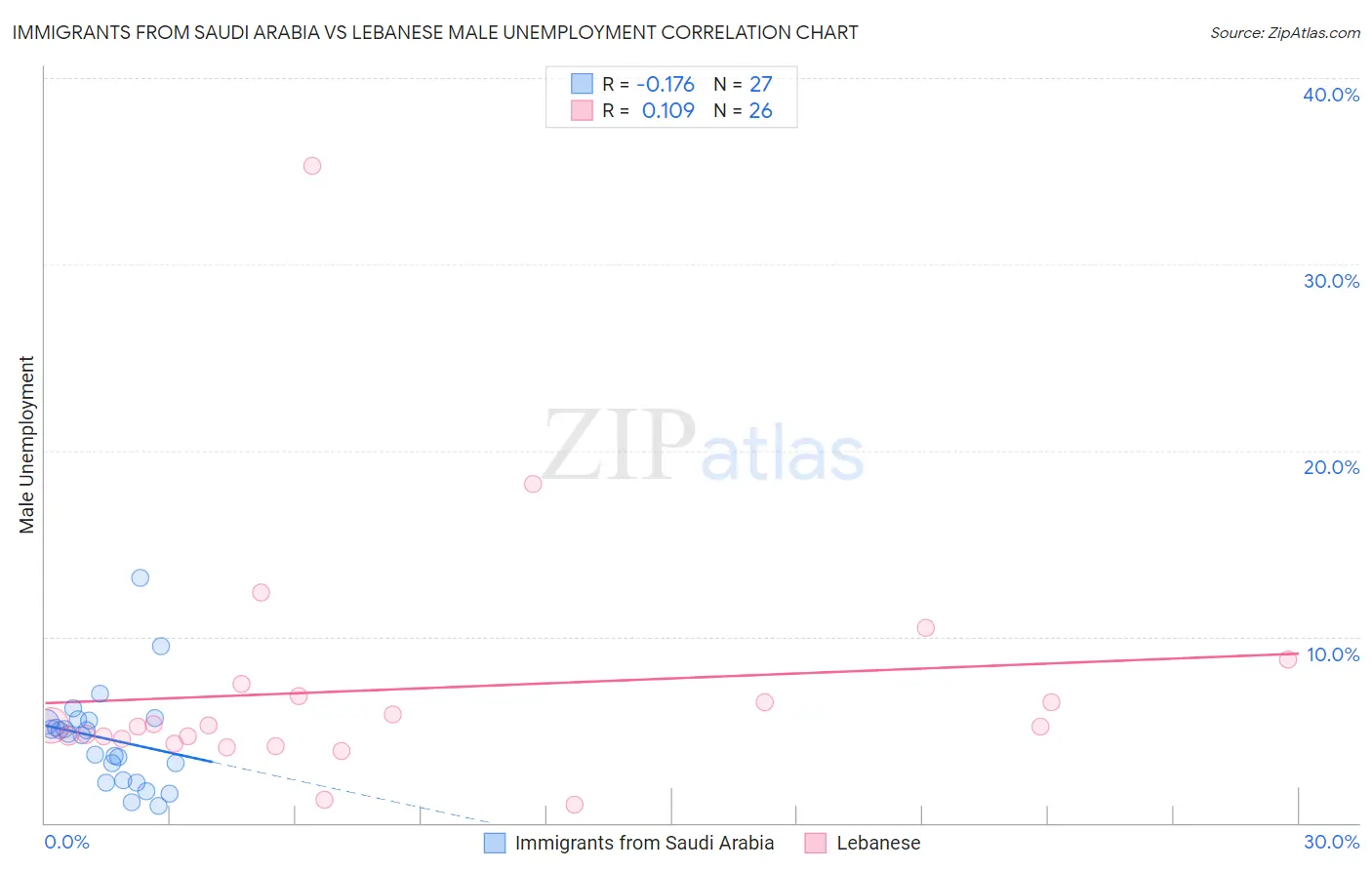Immigrants from Saudi Arabia vs Lebanese Male Unemployment
COMPARE
Immigrants from Saudi Arabia
Lebanese
Male Unemployment
Male Unemployment Comparison
Immigrants from Saudi Arabia
Lebanese
5.2%
MALE UNEMPLOYMENT
80.1/ 100
METRIC RATING
135th/ 347
METRIC RANK
5.2%
MALE UNEMPLOYMENT
79.9/ 100
METRIC RATING
136th/ 347
METRIC RANK
Immigrants from Saudi Arabia vs Lebanese Male Unemployment Correlation Chart
The statistical analysis conducted on geographies consisting of 164,168,129 people shows a poor negative correlation between the proportion of Immigrants from Saudi Arabia and unemployment rate among males in the United States with a correlation coefficient (R) of -0.176 and weighted average of 5.2%. Similarly, the statistical analysis conducted on geographies consisting of 399,936,199 people shows a poor positive correlation between the proportion of Lebanese and unemployment rate among males in the United States with a correlation coefficient (R) of 0.109 and weighted average of 5.2%, a difference of 0.020%.

Male Unemployment Correlation Summary
| Measurement | Immigrants from Saudi Arabia | Lebanese |
| Minimum | 0.90% | 1.0% |
| Maximum | 13.2% | 35.3% |
| Range | 12.3% | 34.3% |
| Mean | 4.5% | 7.2% |
| Median | 4.8% | 5.2% |
| Interquartile 25% (IQ1) | 2.3% | 4.5% |
| Interquartile 75% (IQ3) | 5.5% | 6.8% |
| Interquartile Range (IQR) | 3.2% | 2.2% |
| Standard Deviation (Sample) | 2.6% | 6.7% |
| Standard Deviation (Population) | 2.6% | 6.6% |
Demographics Similar to Immigrants from Saudi Arabia and Lebanese by Male Unemployment
In terms of male unemployment, the demographic groups most similar to Immigrants from Saudi Arabia are Pakistani (5.2%, a difference of 0.030%), Immigrants from Eastern Africa (5.2%, a difference of 0.030%), Immigrants from Croatia (5.2%, a difference of 0.040%), Kenyan (5.2%, a difference of 0.060%), and Brazilian (5.2%, a difference of 0.070%). Similarly, the demographic groups most similar to Lebanese are Immigrants from Eastern Africa (5.2%, a difference of 0.010%), Immigrants from Croatia (5.2%, a difference of 0.020%), Kenyan (5.2%, a difference of 0.040%), Pakistani (5.2%, a difference of 0.050%), and Brazilian (5.2%, a difference of 0.050%).
| Demographics | Rating | Rank | Male Unemployment |
| Immigrants | Lithuania | 87.2 /100 | #125 | Excellent 5.1% |
| Immigrants | Colombia | 86.8 /100 | #126 | Excellent 5.1% |
| Immigrants | Brazil | 86.3 /100 | #127 | Excellent 5.2% |
| Hungarians | 85.1 /100 | #128 | Excellent 5.2% |
| Immigrants | Western Europe | 84.8 /100 | #129 | Excellent 5.2% |
| Immigrants | Malaysia | 83.5 /100 | #130 | Excellent 5.2% |
| Immigrants | Germany | 83.0 /100 | #131 | Excellent 5.2% |
| Chickasaw | 82.9 /100 | #132 | Excellent 5.2% |
| Colombians | 81.1 /100 | #133 | Excellent 5.2% |
| Pakistanis | 80.5 /100 | #134 | Excellent 5.2% |
| Immigrants | Saudi Arabia | 80.1 /100 | #135 | Excellent 5.2% |
| Lebanese | 79.9 /100 | #136 | Good 5.2% |
| Immigrants | Eastern Africa | 79.8 /100 | #137 | Good 5.2% |
| Immigrants | Croatia | 79.7 /100 | #138 | Good 5.2% |
| Kenyans | 79.4 /100 | #139 | Good 5.2% |
| Brazilians | 79.3 /100 | #140 | Good 5.2% |
| Immigrants | Switzerland | 79.2 /100 | #141 | Good 5.2% |
| Fijians | 78.3 /100 | #142 | Good 5.2% |
| Syrians | 78.0 /100 | #143 | Good 5.2% |
| Sri Lankans | 77.9 /100 | #144 | Good 5.2% |
| Macedonians | 77.7 /100 | #145 | Good 5.2% |